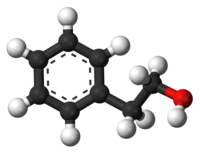Phenethyl alcohol
 |
|
 |
|
| Names | |
|---|---|
|
Preferred IUPAC name
2-Phenylethan-1-ol
|
|
| Other names
2-Phenylethanol
Phenethyl alcohol Benzyl carbinol β-Hydroxyethylbenzene Benzenethanol |
|
| Identifiers | |
|
3D model (Jmol)
|
|
| ChEBI | |
| ChemSpider | |
| DrugBank | |
| ECHA InfoCard | 100.000.415 |
|
PubChem CID
|
|
| UNII | |
|
|
|
|
| Properties | |
| C8H10O | |
| Molar mass | 122.16 g/mol |
| Odor | Soft, like roses |
| Density | 1.017 g/cm3 |
| Melting point | −27 °C (−17 °F; 246 K) |
| Boiling point | 219 to 221 °C (426 to 430 °F; 492 to 494 K) |
| Hazards | |
| Safety data sheet | JT Baker MSDS |
| NFPA 704 | |
|
Except where otherwise noted, data are given for materials in their standard state (at 25 °C [77 °F], 100 kPa).
|
|
|
|
|
| Infobox references | |
Phenethyl alcohol, or 2-phenylethanol, is the organic compound that consists of a phenethyl group (C6H5CH2CH2) group attached to OH. It is a colourless liquid that is slightly soluble in water (2 ml/100 ml H2O), but miscible with most organic solvents. It occurs widely in nature, being found in a variety of essential oils. It has a pleasant floral odor.
Phenethyl alcohol is prepared commercially via two routes. Most common is the Friedel-Crafts reaction between benzene and ethylene oxide in the presence of aluminium trichloride.
The reaction affords the aluminium alkoxide that is subsequently hydrolyzed to the desired product. The main side product is diphenylethane, which can be avoided by use of excess benzene. Hydrogenation of styrene oxide also affords phenethyl alcohol.
Phenethyl alcohol can also be prepared by the reaction between phenylmagnesium bromide and ethylene oxide:
Phenethyl alcohol can also be produced by biotransformation from L-phenylalanine using immobilized yeast Saccharomyces cerevisiae.
Phenethyl alcohol is found in extract of rose, carnation, hyacinth, Aleppo pine, orange blossom, ylang-ylang, geranium, neroli, and champaca. It is also an autoantibiotic produced by the fungus Candida albicans
...
Wikipedia

